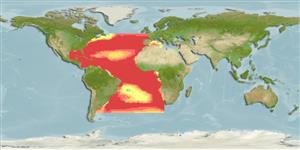Omgeving / Klimaat / Range
Ecologie
; marien; oceanodroom (Ref. 51243); diepteverspreiding 0 - 200 m (Ref. 43). Subtropical; 22°C - 31°C (Ref. 43), preferred 27°C (Ref. 107945); 50°N - 45°S, 98°W - 17°E (Ref. 43)
Atlantic Ocean: in tropical and temperate waters. We follow Nakamura 1985 (Ref. 43) in recognizing Makaira mazara and Makaira nigricans as two distinct species chiefly because of differences in the pattern of the lateral line system. Many scientists, however, do not recognize this character as specifically diagnostic and consider the latter species as a single pantropical species occurring in the Atlantic, Pacific and Indian oceans. Highly migratory species, Annex I of the 1982 Convention on the Law of the Sea (Ref. 26139).
Length at first maturity / Size / Gewicht / Leeftijd
Maturity: Lm ?, range 50 - ? cm
Max length : 500 cm TL mannelijk/geslacht niet bekend; (Ref. 11441); 500.0 cm TL (female); common length : 290 cm TL mannelijk/geslacht niet bekend; (Ref. 6659); Maximaal gepubliceerd gewicht: 636.0 kg (Ref. 40637); Maximaal gepubliceerd gewicht: 636.0 kg
Dorsale stekels (totaal): 0; Dorsale zachte stralen (totaal): 45-50; Anale stekels 0; Anale zachte stralen: 19 - 23. Body blue-black above and silvery white below, with about 15 rows of pale cobalt-colored stripes; 1st dorsal fin plain blackish or dark blue, other fins brown black with a tinge of dark blue in some specimens; anal fin bases with a tinge of silvery white. Lateral line a network of interconnecting canals (Ref. 26938).
Oceanic species. Water color affects its occurrence, at least in the northern Gulf of Mexico, where the fish show preference for blue water. Rarely gathers in schools and usually found as scattered single individuals. Feeds mainly on fishes but also preys on octopods and squids. Marketed fresh or frozen (Ref. 43). Feeding takes place during daytime. Maturity reached at about 80 cm in males and 50 cm in females (Ref. 36731). Females grow larger (Ref. 4770).
Subripe ova are opaque, white to yellow, and 0.3 to 0.5 mm in diameter. Transparent spherical eggs flowing out of a ripe ovary measured 1 mm in diameter.
Nakamura, I., 1985. FAO species catalogue. Vol. 5. Billfishes of the world. An annotated and illustrated catalogue of marlins, sailfishes, spearfishes and swordfishes known to date. FAO Fish. Synop. 125(5):65p. Rome: FAO. (Ref. 43)
Status op de Rode Lijst van het IUCN (Ref. 115185)
CITES (Ref. 94142)
Not Evaluated
Gevaarlijk voor mensen
Harmless
Gebruik door de mens
Visserij: commercieel; vis voor de hengelsport: ja
Meer informatie
ReferentiesAquacultuurAquacultuurprofielKweeklijnenGeneticaAlleelfrequentiesErfelijkheidZiektenVerwerkingMass conversion
Tools
Speciale rapporten
Download XML
Internet-bronnen
Estimates of some properties based on models
Phylogenetic diversity index (Ref.
82805): PD
50 = 0.7505 [Uniqueness, from 0.5 = low to 2.0 = high].
Bayesian length-weight: a=0.00427 (0.00254 - 0.00717), b=3.11 (2.96 - 3.26), in cm Total Length, based on LWR estimates for this species & (Sub)family-body (Ref.
93245).
Trophic Level (Ref.
69278): 4.5 ±0.3 se; Based on diet studies.
Weerstandsvermogen (Ref.
69278): Gemiddeld, minimale populatieverdubbelingstijd 1,4-4,4 jaar (K=0.1-0.3).
Kwetsbaarheid (Ref.
59153): Moderate to high vulnerability (52 of 100) .
